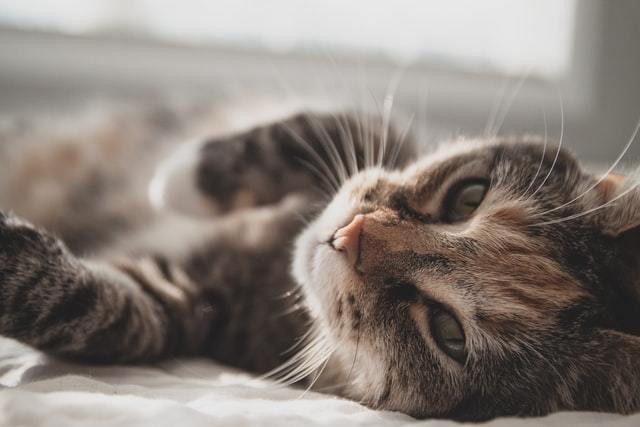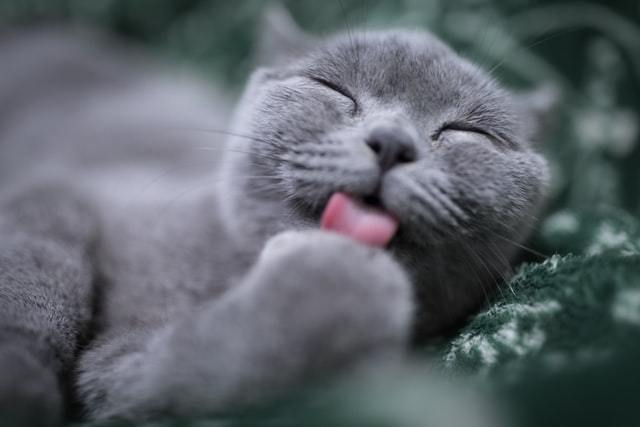Article at a glance
Cat arthritis is incredibly common with over 90% of the senior population affected. Signs can be subtle so many owners are unaware when they have a cat with arthritis.
- Diagnosis is relatively straightforward and usually includes x-rays of the affected joints
- While we cannot cure arthritis, it can be managed with diet, lifestyle changes and medication
- Many cats enjoy a good quality of life despite feline arthritis
The senior cat is a master at hiding signs of pain and many trudge along, pretending all is hunky dory. This is in spite of significant joint disease that is causing them daily pain. As an owner, knowing the signs to look for is very important. Early treatment will reduce discomfort and improve quality of life.
While arthritis can affect any joint, a large number of kitties have arthritis in the back legs. It is reported that the hips are one of the most commonly affected joints. This can present as wobbly or slow walking and a ‘slimmer’ back end.
Causes and signs of arthritis in cats
Despite feline arthritis being a prevalent issue, this literature review highlights how detailed studies on its cause are lacking. We know that many older cats have signs of arthritis on radiographs and have associated mobility issues. Most experts would agree that further studies are needed so we can develop the best cat arthritis treatment.
Signs are not always easy to spot and may wax and wane, making it even trickier to be sure of what you are seeing. Cat arthritis symptoms can include:
- A reduced willingness to be social and spend time around the family
- Hiding away in quieter parts of the home
- Sleeping more
- Grooming less
- A loss of muscle mass, especially over the back and hind limbs
- Reduced desire to play, run and jump
- Hesitation before jumping
- Stiffness, especially in the morning or after a long sleep
- Grumpiness when being touched
How Is Cat Arthritis Diagnosed?
A vet will usually be suspicious of arthritis from examining the cat. They will perform a physical exam and orthopaedic assessment, checking joint mobility. Signs such as crepitus (abnormal crackling or popping sounds coming from the joint) will be checked for. The vet will also determine if the muscles have wasted away and if the cat has a limited range of motion.
If joint disease is suspected, radiographs should be performed to rule out other potential issues such as a joint infection or tumour. These x-rays are done under general anaesthetic and at least two views are required.
The degree of arthritis that shows up on the x-rays does not always directly correlate to how badly the cat is affected. So, a cat that is very lame may only have very subtle radiographic changes. The reverse can also be true.
Cat arthritis treatment
For most owners, the first question they will ask is ‘What can I give my cat for arthritis pain?’. They are fully aware that their cat is in discomfort and needs relief. Thankfully, there are a range of treatment options available. Cat arthritis treatment is not the same for every individual and a tailor-made plan should be created by your vet.
For the vast majority, prescription cat arthritis medicine including pain relief and anti-inflammatories is the cornerstone of treatment. They help to minimise joint inflammation and improve quality of life. These are usually liquid or tablet medicines that are given with food once daily.
As some medicine can potentially affect the liver and kidneys when given long-term, it is advised that a blood test is run every 6 months. This is to evaluate liver and kidney health and to determine if we need to alter the medicine type or dose.
Importantly, many owners worry about causing harm when giving long-term non-steroidal anti-inflammatories. Some are so concerned that they choose not to medicate their cats. This is usually ill-advised. Indeed, a recent study carried out in 2020 found that there was no decline in renal function when cats with kidney disease were given Meloxicam (a common NSAID used in arthritis treatment for cats).
Home Remedies for Cat Arthritis
Though most of those with arthritis will need prescribed medicine, there are some treatment options available from the comfort of your own home. These should form part of the overall treatment plan and should not be trialled in place of the medicine issued by the vet.
We can help our kitties by keeping the home warm in the winter and providing heated, orthopaedic beds. We can also modify their environment by placing non-slip mats over hardwood floors. Sometimes, ramps are useful if your cat likes access to high up spots such as sofas or your bed.
Prevention Methods
As experts are uncertain as to the cause of arthritis in cats, it is difficult to know how to prevent it. However, there are some widely accepted recommendations.
- Keeping your cat slim should help to reduce pressure on their joints. Aim for a Body Condition Score of 4 or 5 out of 9.
- Start joint supplements at a young age; read more about this in the next paragraph.
- Consider a joint supportive diet such as Royal Canin Mobility or Hill’s j/d.
- Regularly exercise your cat and encourage play. Try not to overdo it, but ensure your cat is kept mobile, regardless of their age.
- Schedule regular vet check ups so any early arthritis can be picked up.
We Recommend This Hip n' Joint Vitalize Support
Supplements such as This Hip ‘n’ Joint Vitalize Support from Scruffy Paws is an excellent choice in both the prevention and management of feline arthritis. Owners love the fact that it is highly palatable and is in liquid form, making it easy to administer.

Made with quality ingredients such as Glucosamine, Chondroitin, MSM, Hyaluronic acid and Taurine, your cats joints are well supported.
Final Thoughts
Feline arthritis is a common diagnosis. It can be a shock to hear that your cat has a progressive joint disease. However, there are many treatments available to keep your cat comfortable and happy.
Dr. Linda Simon, BVMS, MRCVS
Veterinary surgeon,Dr. Linda Simon MVB MRCVS is a locum veterinary surgeon who has worked in London for the past 8 years. She graduated top of her class in small animal medicine from UCD, Dublin. She is currently a member of the Royal College of Veterinary Surgeons.



